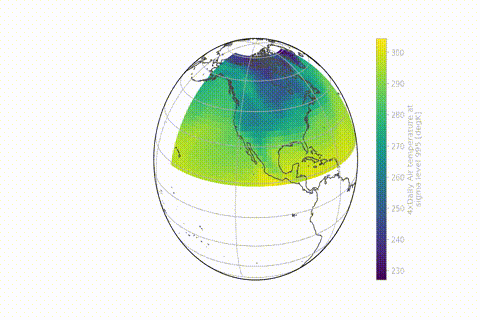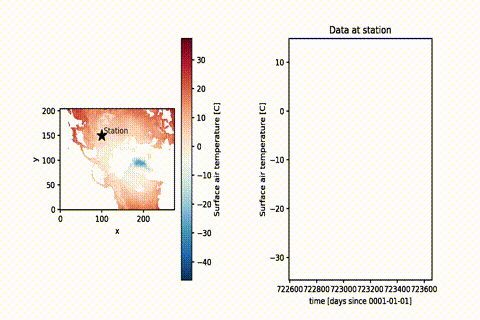xmovie
A simple way of creating beautiful movies from xarray objects.
With ever increasing detail, modern scientific observations and model results lend themselves to visualization in the form of movies.
Not only is a beautiful movie a fantastic way to wake up the crowd on a Friday afternoon of a weeklong conference, but it can also speed up the discovery process, since our eyes are amazing image processing devices.
This module aims to facilitate movie rendering from data object based on xarray objects.
Xarray already provides a way to create quick and beautiful static images from your data. animatplot works towards animating these 'standard' xarray plots.
But it can become tedious to customize plots, particularly when map projections are used.
The main aims of this module are:
- Enable quick but high quality movie frame creation from existing xarray objects with preset plot functions - create a movie with only 2 lines of code.
- Provide high quality, customizable presets to create stunning visualizations with minimal setup.
- Convert your static plot workflow to a movie with only a few lines of code, while maintaining all the flexibility of xarray and matplotlib.
Installation
Clone this repository with $ git clone git@github.com:jbusecke/xmovie.git and
install it from source $ python setup.py install.
Pip and conda distributions will be available soon.
If you dont have ssh keys set up, you can use
$ git clone https://github.com/jbusecke/xmovie.gitand enter your github password.
Quickstart
Making high quality movies and gifs can be created with only a few lines
import xarray as xr
from xmovie import Movie
ds = xr.tutorial.open_dataset('air_temperature').isel(time=slice(0,150))
mov = Movie(ds.air)
mov.save('movie.mp4')Saving a .gif is as easy as changing the filename:
mov.save('movie.gif')That is it! Now pat yourself on the shoulder and enjoy your masterpiece.

The gif is created by first rendering a movie and then converting it to a gif. If you want to keep both outputs you can simply do
mov.save('movie.gif', remove_movie=False)
Preview movie frames
Preview single frames in the movie with the Movie.preview function:
# preview 10th frame
mov.preview(10)
Plot presets
xmovie provides several presets to enable quick creation of animated vizualizations
from xmovie.presets import rotating_globe
# specify custom plotfunctions (here a preset from xmovie)
mov = Movie(ds.air, plotfunc=rotating_globe)
mov.save('movie_rotating.gif', progress=True)Modify plots
The preset plot-functions each have a unique set of keyword arguments for custom looks, but they all support the xarray plotting modes via the plotmethod keyword.
For a more detailed demonstration see this notebook.
Custom Plots
You can customize any plot based on an xarray data structure and a 'frame-dimension' (usually time, or another dimension that will evolve with time in the movie).
Take this example:
# some awesome static plot
import matplotlib.pyplot as plt
ds = xr.tutorial.open_dataset('rasm').Tair
fig = plt.figure(figsize=[10,5])
tt = 30
station = dict(x=100, y=150)
ds_station = ds.sel(**station)
(ax1, ax2) = fig.subplots(ncols=2)
ds.isel(time=tt).plot(ax=ax1)
ax1.plot(station['x'], station['y'], marker='*', color='k' ,markersize=15)
ax1.text(station['x']+4, station['y']+4, 'Station', color='k' )
ax1.set_aspect(1)
ax1.set_facecolor('0.5')
ax1.set_title('');
# Time series
ds_station.isel(time=slice(0,tt+1)).plot.line(ax=ax2, x='time')
ax2.set_xlim(ds.time.min().data, ds.time.max().data)
ax2.set_ylim(ds_station.min(), ds_station.max())
ax2.set_title('Data at station');
fig.subplots_adjust(wspace=0.6)
All that is needed to wrap this into a function with the signature func(ds, fig, timestamp, **kwargs), where ds is an xarray Dataset or DataArray, fig is a matplotlib.figure object and timestamp is an integer which indicates the movie frame.
def custom_plotfunc(ds, fig, tt):
# Define station location for timeseries
station = dict(x=100, y=150)
ds_station = ds.sel(**station)
(ax1, ax2) = fig.subplots(ncols=2)
# Map axis
# Colorlimits need to be fixed or your video is going to cause seizures.
# This is the only modification from the code above!
ds.isel(time=tt).plot(ax=ax1, vmin=ds.min(), vmax=ds.max(), cmap='RdBu_r')
ax1.plot(station['x'], station['y'], marker='*', color='k' ,markersize=15)
ax1.text(station['x']+4, station['y']+4, 'Station', color='k' )
ax1.set_aspect(1)
ax1.set_facecolor('0.5')
ax1.set_title('');
# Time series
ds_station.isel(time=slice(0,tt+1)).plot.line(ax=ax2, x='time')
ax2.set_xlim(ds.time.min().data, ds.time.max().data)
ax2.set_ylim(ds_station.min(), ds_station.max())
ax2.set_title('Data at station');
fig.subplots_adjust(wspace=0.4)
mov_custom = Movie(ds, custom_plotfunc)
mov_custom.save('movie_custom.gif')



